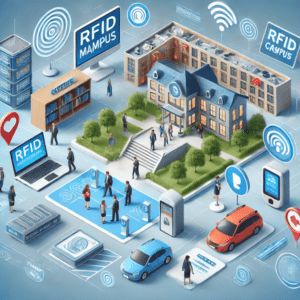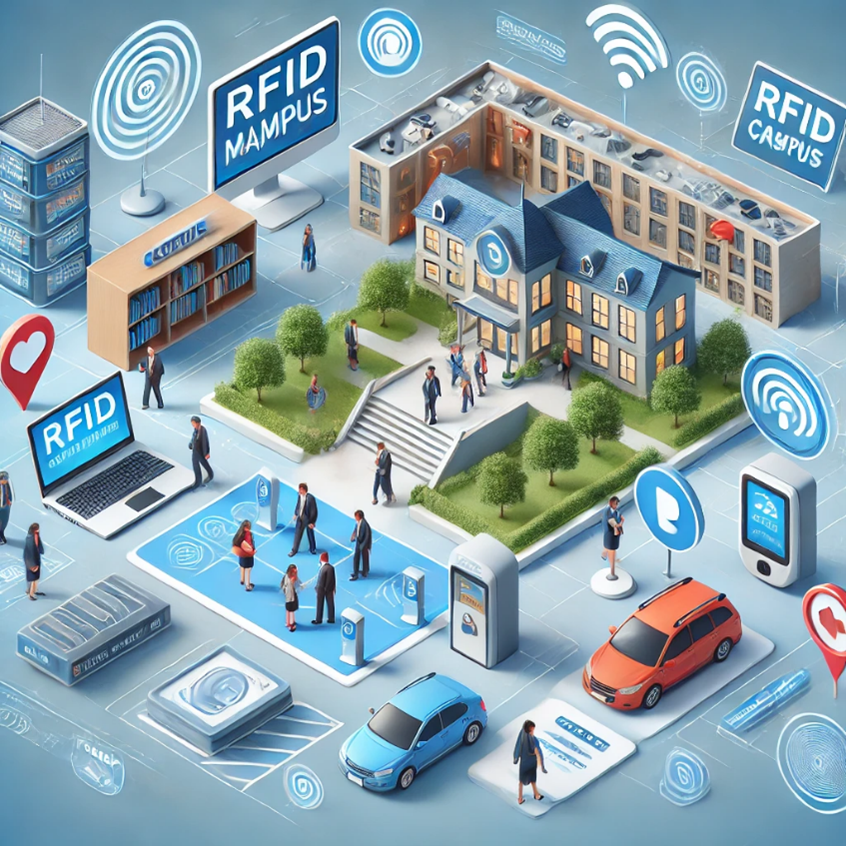Colleges and schools today are adopting new technologies to simplify campus functions. RFID Campus Management Systems are one such example, helping institutions handle everyday tasks more effectively while improving security and making life easier for students, staff, and administrators.
What is an RFID Campus Management System?
An RFID (Radio Frequency Identification) Campus Management System is a solution that helps automate and manage different campus activities. It works by using RFID tags, readers, and software to track and monitor people, items, and resources within the campus.
For example, it can be used to record student attendance, manage library books, and control access to specific areas, such as labs or hostels. By simplifying these tasks, an RFID system makes campus operations more smooth.

How Does an RFID Campus Management System Work?
An RFID Campus Management System works using three main components that work together for campus operations:
-
RFID Tags :
These are small, unique devices that store information. Each tag contains a microchip and can be attached to ID cards, books, vehicles, or other items you want to track.
-
RFID Readers :
These are devices placed at key locations, such as gates, classrooms entry/exits, and libraries, to scan the information stored on the tags. They use radio waves to detect and read the data from nearby tags.
-
Management Software :
This is the system that collects data from the readers, processes it, and performs tasks like recording attendance or allocating resources. The software helps organize and present the information in a way that’s easy to use.
To put it simply , when a tagged item or person comes near an RFID reader, the reader detects the tag and sends the information to the software. The software then processes the data, completing tasks automatically, such as marking attendance or updating library records. This process is quick, accurate, and removes the need for manual effort.
How is RFID Campus Management Implemented ?
Implementing an RFID Campus Management System involves a series of steps to ensure the technology meets the campus's specific needs and functions smoothly:
-
Step 1: Needs Assessment
The process begins by identifying the campus’s specific requirements. This could involve tracking student attendance, managing library resources, controlling vehicle parking, or restricting access to sensitive areas. Understanding these needs helps define the functionalities that the RFID system must deliver.
-
Step 2: Planning and Design
Once the needs are clear, a detailed implementation plan is created. This includes deciding on the locations for RFID readers, selecting the types of tags required (for ID cards, books, or vehicles), and customizing the software to align with the campus's workflows.
Types of RFID tags -
Step 3: Installation of Hardware
RFID readers are installed at key locations, such as entry/exit points, classrooms, libraries, and parking areas. Simultaneously, RFID tags are embedded in ID cards issued to students and staff and attached to important assets like books or vehicles. This setup enables tracking and monitoring across the campus.
-
Step 4: Software Integration
The RFID system is integrated with the institution’s existing management software to create a unified platform for campus operations. This integration enables data flow between different systems, ensuring that information is updated in real-time . Tasks such as marking student attendance, managing library transactions, and controlling access to restricted areas become automated. Additionally, this setup reduces the chances of errors.
-
Step 5: Testing and Training
Before full deployment, the system undergoes thorough testing to ensure all components are functioning as intended. Training sessions are conducted for staff to help them understand the system’s operation and make the transition to the new technology smooth.
-
Step 6: Go-Live
After successful testing and staff training, the system is fully launched. The RFID Campus Management System becomes operational, Helping with day-to-day campus activities
How RFID campus management system Works for Attendance, Library Transactions, and Access Control
-
Attendance Tracking :
When a student or staff member enters a classroom or other designated areas, they simply scan their RFID-enabled ID card at the reader placed at the entry point. The RFID reader detects the unique ID stored in the card’s RFID tag and sends the data to the integrated software. The system automatically records the attendance of the person based on the time and location of the scan. This eliminates the need for manual roll calls, saving time and reducing errors. The attendance data is updated in real-time and can be accessed by administrators for monitoring and reports.
Checkout 2CQR’S RFID Based attendance tracking -
Library Transactions :
In the library, each book is tagged with an RFID tag. When a student or staff member wishes to borrow or return a book, the staff/student simply place the book on the RFID reader at the checkout counter or self-service station. The RFID reader scans the tag and sends the book's information to the management software, which updates the library's database in real-time. Similarly, when returning books, the reader scans the RFID tags to mark the item as returned and update the inventory.
-
Access Control :
RFID readers are placed at various entry points, such as doors to restricted areas (labs, hostels, staff rooms, etc.). Students and staff carry their RFID-enabled ID cards, which are scanned when they approach a restricted entry. The RFID reader checks the information stored in the ID card and compares it with the access permissions set in the system. If the person is authorized to enter, the door automatically unlocks; otherwise, access is denied. This system improves security by ensuring only authorized individuals can enter sensitive areas, and it also keeps a log of all access events for monitoring purposes.
Pros and Cons of RFID Campus Management Systems
The Upside :
RFID technology brings a new level of simplicity and precision to campus management. Attendance is automatically recorded as individuals pass through designated areas, eliminating the need for manual roll calls. Library transactions are simplified with automated check-ins and check-outs, making resource management more easier.. Access control is in ensured, as only authorized personnel can enter restricted areas, thus improving campus security.
The system operates in real time, providing administrators with up-to-date information for better monitoring and decision-making. By automating repetitive tasks, RFID reduces errors too. While the initial investment might be significant, the long-term savings in operational costs and effectiveness make it a worthwhile addition for educational institutions.
The Flipside :
Setting up an RFID system comes with a hefty upfront cost—not just for the hardware and software but also for training and maintenance. Then there’s the challenge of merging this modern tech with existing systems, which often requires skilled expertise. Privacy concerns can’t be overlooked either, as tracking people and items comes with the responsibility of safeguarding sensitive data. Lastly, like any new technology, getting everyone on board—from students to staff—takes time and patience.
A Balanced approach :
RFID offers an exciting leap forward for campus management, but it’s not just about adopting the technology. It’s about implementing it thoughtfully, addressing challenges head-on, and ensuring that the benefits outweigh the initial bumps along the way. Done right, it’s a game-changer for educational institutions.

